CNA255 Assignment: Prioritizing Nursing Diagnoses for Mr. G
VerifiedAdded on 2023/01/23
|5
|1026
|39
Homework Assignment
AI Summary
This assignment focuses on a patient, Mr. G, who presented with symptoms after a marathon, including confusion and lack of urination. The student identifies and prioritizes two nursing diagnoses: fluid volume deficit and risk of infection. The student provides a rationale for prioritization, linking the diagnoses to the patient's assessment findings and underlying physiology. The assignment includes detailed goals, related nursing actions with rationales, and evaluation outcomes for each diagnosis. The care plan is evidence-based and specific to the patient's circumstances, referencing relevant literature. The student reflects on the simulated episode, emphasizing the importance of accurate nursing diagnosis for effective care. The assignment demonstrates understanding of the clinical reasoning cycle and the application of nursing standards.
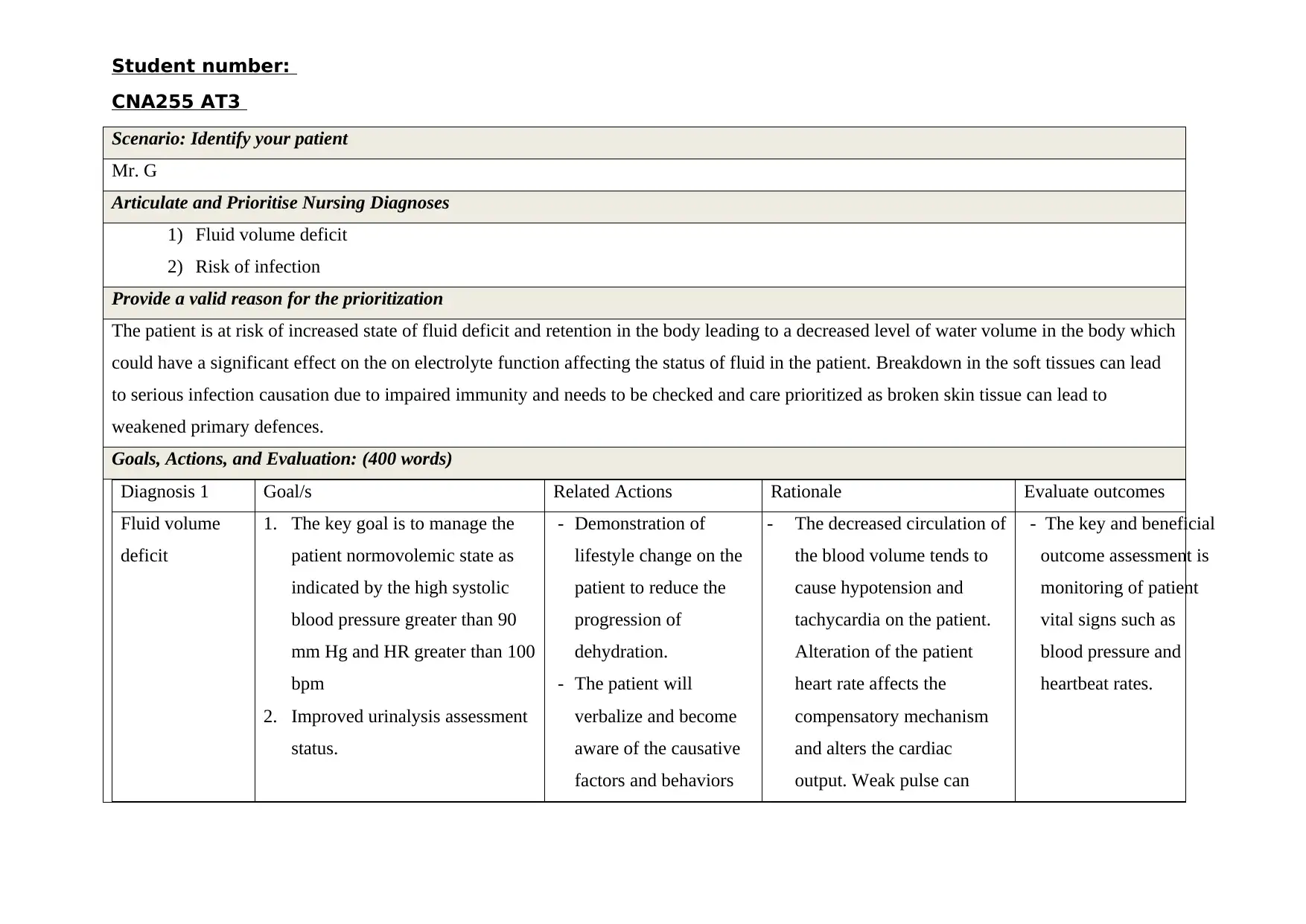
Student number:
CNA255 AT3
Scenario: Identify your patient
Mr. G
Articulate and Prioritise Nursing Diagnoses
1) Fluid volume deficit
2) Risk of infection
Provide a valid reason for the prioritization
The patient is at risk of increased state of fluid deficit and retention in the body leading to a decreased level of water volume in the body which
could have a significant effect on the on electrolyte function affecting the status of fluid in the patient. Breakdown in the soft tissues can lead
to serious infection causation due to impaired immunity and needs to be checked and care prioritized as broken skin tissue can lead to
weakened primary defences.
Goals, Actions, and Evaluation: (400 words)
Diagnosis 1 Goal/s Related Actions Rationale Evaluate outcomes
Fluid volume
deficit
1. The key goal is to manage the
patient normovolemic state as
indicated by the high systolic
blood pressure greater than 90
mm Hg and HR greater than 100
bpm
2. Improved urinalysis assessment
status.
- Demonstration of
lifestyle change on the
patient to reduce the
progression of
dehydration.
- The patient will
verbalize and become
aware of the causative
factors and behaviors
- The decreased circulation of
the blood volume tends to
cause hypotension and
tachycardia on the patient.
Alteration of the patient
heart rate affects the
compensatory mechanism
and alters the cardiac
output. Weak pulse can
- The key and beneficial
outcome assessment is
monitoring of patient
vital signs such as
blood pressure and
heartbeat rates.
CNA255 AT3
Scenario: Identify your patient
Mr. G
Articulate and Prioritise Nursing Diagnoses
1) Fluid volume deficit
2) Risk of infection
Provide a valid reason for the prioritization
The patient is at risk of increased state of fluid deficit and retention in the body leading to a decreased level of water volume in the body which
could have a significant effect on the on electrolyte function affecting the status of fluid in the patient. Breakdown in the soft tissues can lead
to serious infection causation due to impaired immunity and needs to be checked and care prioritized as broken skin tissue can lead to
weakened primary defences.
Goals, Actions, and Evaluation: (400 words)
Diagnosis 1 Goal/s Related Actions Rationale Evaluate outcomes
Fluid volume
deficit
1. The key goal is to manage the
patient normovolemic state as
indicated by the high systolic
blood pressure greater than 90
mm Hg and HR greater than 100
bpm
2. Improved urinalysis assessment
status.
- Demonstration of
lifestyle change on the
patient to reduce the
progression of
dehydration.
- The patient will
verbalize and become
aware of the causative
factors and behaviors
- The decreased circulation of
the blood volume tends to
cause hypotension and
tachycardia on the patient.
Alteration of the patient
heart rate affects the
compensatory mechanism
and alters the cardiac
output. Weak pulse can
- The key and beneficial
outcome assessment is
monitoring of patient
vital signs such as
blood pressure and
heartbeat rates.
Paraphrase This Document
Need a fresh take? Get an instant paraphrase of this document with our AI Paraphraser
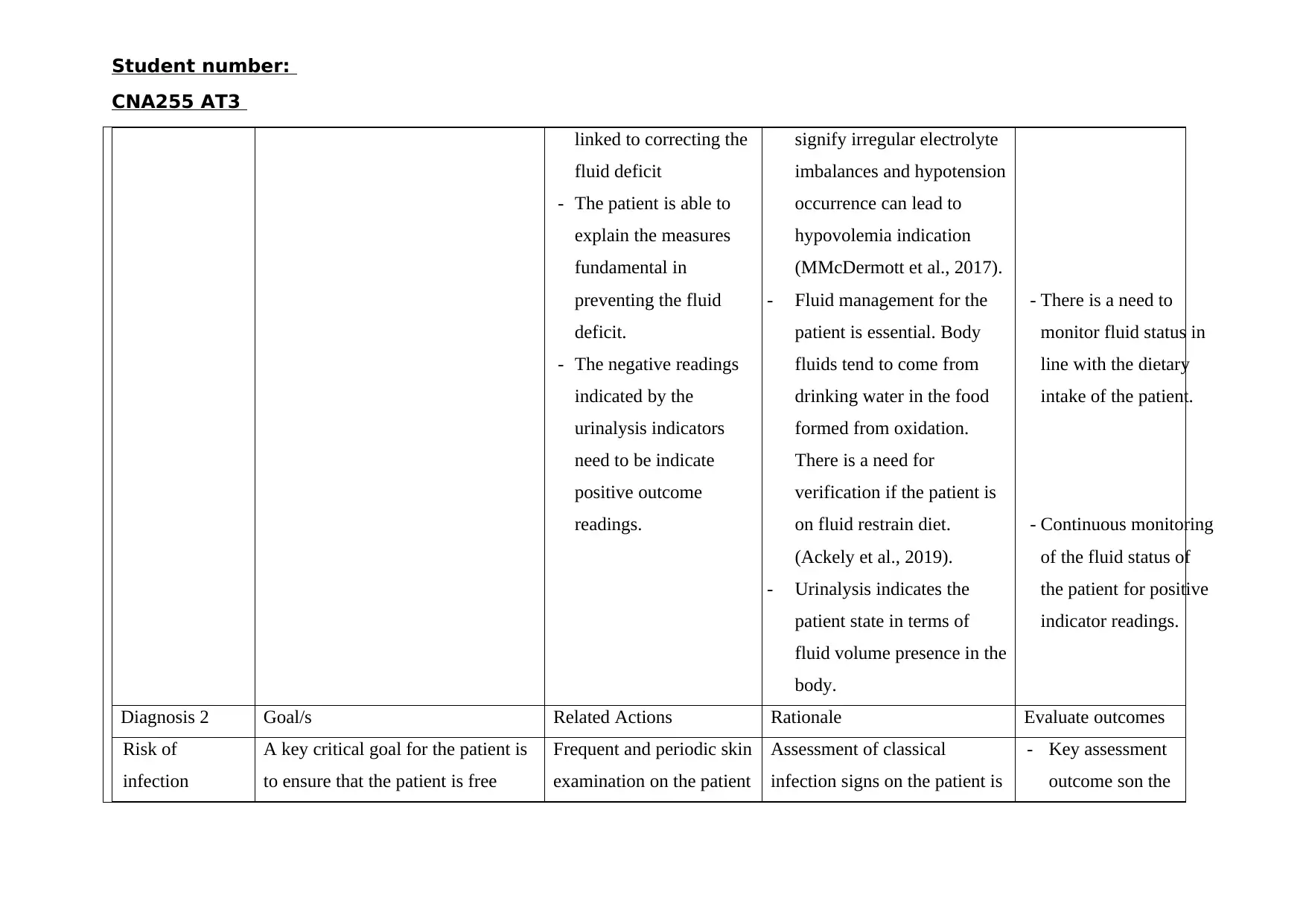
Student number:
CNA255 AT3
linked to correcting the
fluid deficit
- The patient is able to
explain the measures
fundamental in
preventing the fluid
deficit.
- The negative readings
indicated by the
urinalysis indicators
need to be indicate
positive outcome
readings.
signify irregular electrolyte
imbalances and hypotension
occurrence can lead to
hypovolemia indication
(MMcDermott et al., 2017).
- Fluid management for the
patient is essential. Body
fluids tend to come from
drinking water in the food
formed from oxidation.
There is a need for
verification if the patient is
on fluid restrain diet.
(Ackely et al., 2019).
- Urinalysis indicates the
patient state in terms of
fluid volume presence in the
body.
- There is a need to
monitor fluid status in
line with the dietary
intake of the patient.
- Continuous monitoring
of the fluid status of
the patient for positive
indicator readings.
Diagnosis 2 Goal/s Related Actions Rationale Evaluate outcomes
Risk of
infection
A key critical goal for the patient is
to ensure that the patient is free
Frequent and periodic skin
examination on the patient
Assessment of classical
infection signs on the patient is
- Key assessment
outcome son the
CNA255 AT3
linked to correcting the
fluid deficit
- The patient is able to
explain the measures
fundamental in
preventing the fluid
deficit.
- The negative readings
indicated by the
urinalysis indicators
need to be indicate
positive outcome
readings.
signify irregular electrolyte
imbalances and hypotension
occurrence can lead to
hypovolemia indication
(MMcDermott et al., 2017).
- Fluid management for the
patient is essential. Body
fluids tend to come from
drinking water in the food
formed from oxidation.
There is a need for
verification if the patient is
on fluid restrain diet.
(Ackely et al., 2019).
- Urinalysis indicates the
patient state in terms of
fluid volume presence in the
body.
- There is a need to
monitor fluid status in
line with the dietary
intake of the patient.
- Continuous monitoring
of the fluid status of
the patient for positive
indicator readings.
Diagnosis 2 Goal/s Related Actions Rationale Evaluate outcomes
Risk of
infection
A key critical goal for the patient is
to ensure that the patient is free
Frequent and periodic skin
examination on the patient
Assessment of classical
infection signs on the patient is
- Key assessment
outcome son the
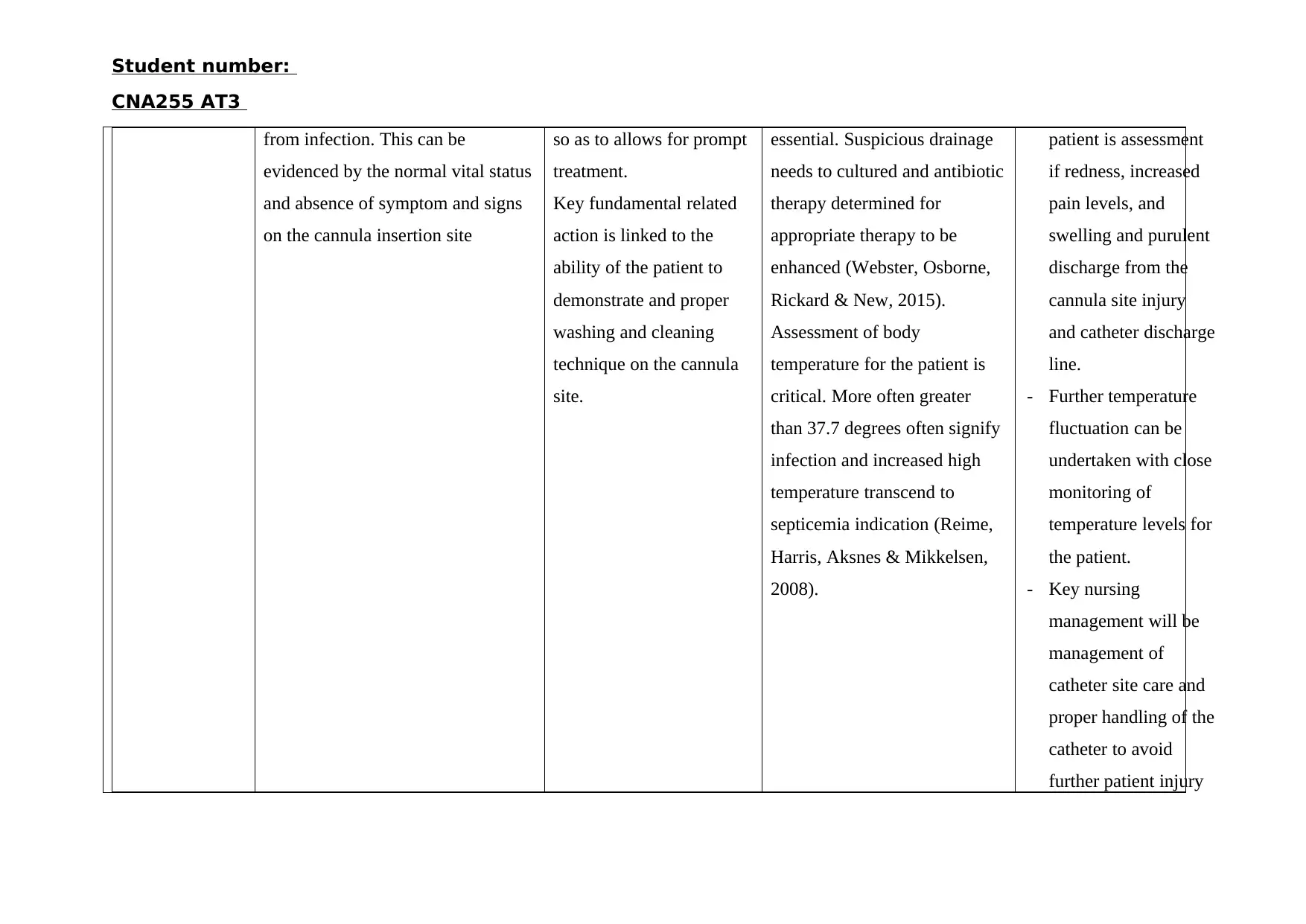
Student number:
CNA255 AT3
from infection. This can be
evidenced by the normal vital status
and absence of symptom and signs
on the cannula insertion site
so as to allows for prompt
treatment.
Key fundamental related
action is linked to the
ability of the patient to
demonstrate and proper
washing and cleaning
technique on the cannula
site.
essential. Suspicious drainage
needs to cultured and antibiotic
therapy determined for
appropriate therapy to be
enhanced (Webster, Osborne,
Rickard & New, 2015).
Assessment of body
temperature for the patient is
critical. More often greater
than 37.7 degrees often signify
infection and increased high
temperature transcend to
septicemia indication (Reime,
Harris, Aksnes & Mikkelsen,
2008).
patient is assessment
if redness, increased
pain levels, and
swelling and purulent
discharge from the
cannula site injury
and catheter discharge
line.
- Further temperature
fluctuation can be
undertaken with close
monitoring of
temperature levels for
the patient.
- Key nursing
management will be
management of
catheter site care and
proper handling of the
catheter to avoid
further patient injury
CNA255 AT3
from infection. This can be
evidenced by the normal vital status
and absence of symptom and signs
on the cannula insertion site
so as to allows for prompt
treatment.
Key fundamental related
action is linked to the
ability of the patient to
demonstrate and proper
washing and cleaning
technique on the cannula
site.
essential. Suspicious drainage
needs to cultured and antibiotic
therapy determined for
appropriate therapy to be
enhanced (Webster, Osborne,
Rickard & New, 2015).
Assessment of body
temperature for the patient is
critical. More often greater
than 37.7 degrees often signify
infection and increased high
temperature transcend to
septicemia indication (Reime,
Harris, Aksnes & Mikkelsen,
2008).
patient is assessment
if redness, increased
pain levels, and
swelling and purulent
discharge from the
cannula site injury
and catheter discharge
line.
- Further temperature
fluctuation can be
undertaken with close
monitoring of
temperature levels for
the patient.
- Key nursing
management will be
management of
catheter site care and
proper handling of the
catheter to avoid
further patient injury
⊘ This is a preview!⊘
Do you want full access?
Subscribe today to unlock all pages.

Trusted by 1+ million students worldwide
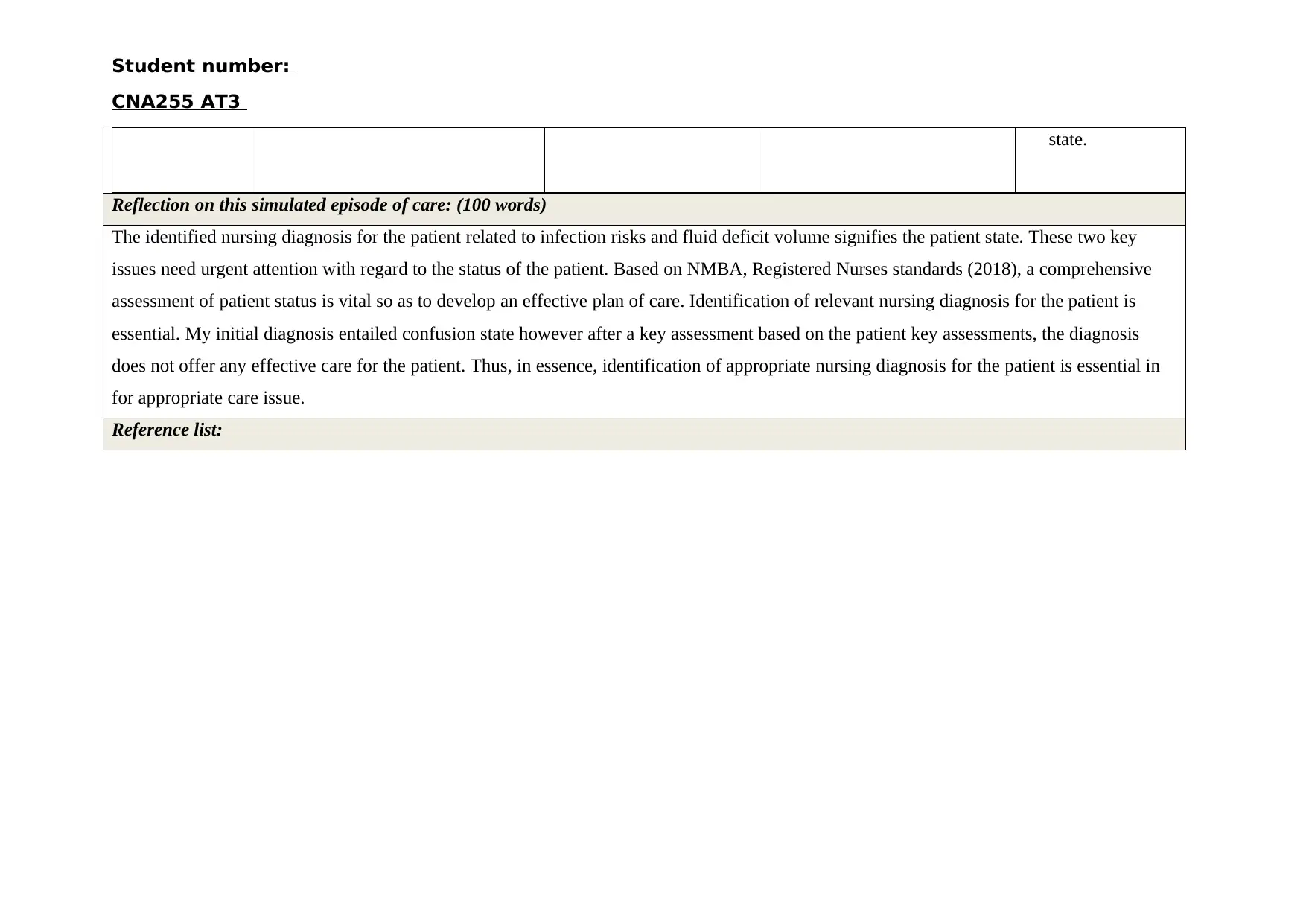
Student number:
CNA255 AT3
state.
Reflection on this simulated episode of care: (100 words)
The identified nursing diagnosis for the patient related to infection risks and fluid deficit volume signifies the patient state. These two key
issues need urgent attention with regard to the status of the patient. Based on NMBA, Registered Nurses standards (2018), a comprehensive
assessment of patient status is vital so as to develop an effective plan of care. Identification of relevant nursing diagnosis for the patient is
essential. My initial diagnosis entailed confusion state however after a key assessment based on the patient key assessments, the diagnosis
does not offer any effective care for the patient. Thus, in essence, identification of appropriate nursing diagnosis for the patient is essential in
for appropriate care issue.
Reference list:
CNA255 AT3
state.
Reflection on this simulated episode of care: (100 words)
The identified nursing diagnosis for the patient related to infection risks and fluid deficit volume signifies the patient state. These two key
issues need urgent attention with regard to the status of the patient. Based on NMBA, Registered Nurses standards (2018), a comprehensive
assessment of patient status is vital so as to develop an effective plan of care. Identification of relevant nursing diagnosis for the patient is
essential. My initial diagnosis entailed confusion state however after a key assessment based on the patient key assessments, the diagnosis
does not offer any effective care for the patient. Thus, in essence, identification of appropriate nursing diagnosis for the patient is essential in
for appropriate care issue.
Reference list:
Paraphrase This Document
Need a fresh take? Get an instant paraphrase of this document with our AI Paraphraser
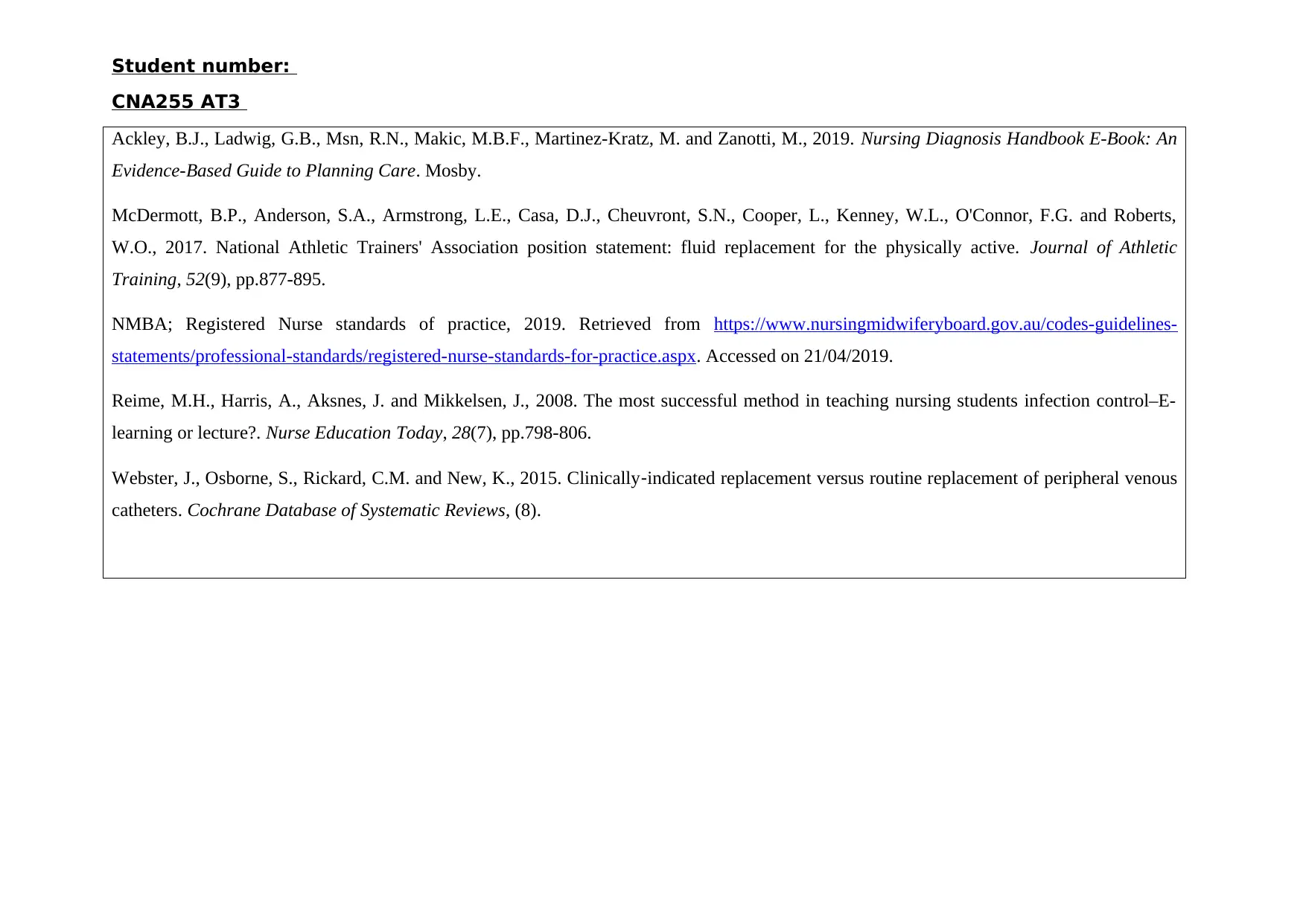
Student number:
CNA255 AT3
Ackley, B.J., Ladwig, G.B., Msn, R.N., Makic, M.B.F., Martinez-Kratz, M. and Zanotti, M., 2019. Nursing Diagnosis Handbook E-Book: An
Evidence-Based Guide to Planning Care. Mosby.
McDermott, B.P., Anderson, S.A., Armstrong, L.E., Casa, D.J., Cheuvront, S.N., Cooper, L., Kenney, W.L., O'Connor, F.G. and Roberts,
W.O., 2017. National Athletic Trainers' Association position statement: fluid replacement for the physically active. Journal of Athletic
Training, 52(9), pp.877-895.
NMBA; Registered Nurse standards of practice, 2019. Retrieved from https://www.nursingmidwiferyboard.gov.au/codes-guidelines-
statements/professional-standards/registered-nurse-standards-for-practice.aspx. Accessed on 21/04/2019.
Reime, M.H., Harris, A., Aksnes, J. and Mikkelsen, J., 2008. The most successful method in teaching nursing students infection control–E-
learning or lecture?. Nurse Education Today, 28(7), pp.798-806.
Webster, J., Osborne, S., Rickard, C.M. and New, K., 2015. Clinically‐indicated replacement versus routine replacement of peripheral venous
catheters. Cochrane Database of Systematic Reviews, (8).
CNA255 AT3
Ackley, B.J., Ladwig, G.B., Msn, R.N., Makic, M.B.F., Martinez-Kratz, M. and Zanotti, M., 2019. Nursing Diagnosis Handbook E-Book: An
Evidence-Based Guide to Planning Care. Mosby.
McDermott, B.P., Anderson, S.A., Armstrong, L.E., Casa, D.J., Cheuvront, S.N., Cooper, L., Kenney, W.L., O'Connor, F.G. and Roberts,
W.O., 2017. National Athletic Trainers' Association position statement: fluid replacement for the physically active. Journal of Athletic
Training, 52(9), pp.877-895.
NMBA; Registered Nurse standards of practice, 2019. Retrieved from https://www.nursingmidwiferyboard.gov.au/codes-guidelines-
statements/professional-standards/registered-nurse-standards-for-practice.aspx. Accessed on 21/04/2019.
Reime, M.H., Harris, A., Aksnes, J. and Mikkelsen, J., 2008. The most successful method in teaching nursing students infection control–E-
learning or lecture?. Nurse Education Today, 28(7), pp.798-806.
Webster, J., Osborne, S., Rickard, C.M. and New, K., 2015. Clinically‐indicated replacement versus routine replacement of peripheral venous
catheters. Cochrane Database of Systematic Reviews, (8).
1 out of 5
Related Documents
Your All-in-One AI-Powered Toolkit for Academic Success.
+13062052269
info@desklib.com
Available 24*7 on WhatsApp / Email
![[object Object]](/_next/static/media/star-bottom.7253800d.svg)
Unlock your academic potential
Copyright © 2020–2025 A2Z Services. All Rights Reserved. Developed and managed by ZUCOL.





